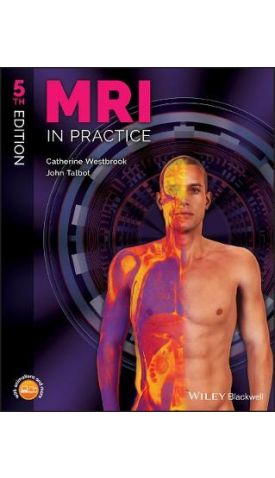אנו משתמשים ב-Cookies כדי לשפר את החוויה שלך. כדי לקיים ההנחיה החדשה של e-Privacy, עלינו לבקש את הסכמתך להגדיר את ה-Cookies. קבלת מידע נוסף.
264.00 ₪
MRI in Practice, 5th Edition
264.00 ₪
ISBN13
9781119391968
יצא לאור ב
Hoboken
מהדורה
5th Edition
זמן אספקה
21 ימי עסקים
עמודים
416
פורמט
Paperback / softback
תאריך יציאה לאור
26 באוק׳ 2018
מחליף את פריט
1A444337430
MRI in Practice continues to be the number one reference book and study guide for the registry review examination for MRI offered by the American Registry for Radiologic Technologists (ARRT). This latest edition offers in-depth chapters covering all core areas, including: basic principles, image weighting and contrast, spin and gradient echo pulse sequences, spatial encoding, k-space, protocol optimization, artefacts, instrumentation, and MRI safety.
The leading MRI reference book and study guide.
Now with a greater focus on the physics behind MRI.
Offers, for the first time, equations and their explanations and scan tips.
Brand new chapters on MRI equipment, vascular imaging and safety.
Presented in full color, with additional illustrations and high-quality MRI images to aid understanding.
Includes refined, updated and expanded content throughout, along with more learning tips and practical applications.
Features a new glossary.
MRI in Practice is an important text for radiographers, technologists, radiology residents, radiologists, and other students and professionals working within imaging, including medical physicists and nurses.
| מהדורה | 5th Edition |
|---|---|
| עמודים | 416 |
| מחליף את פריט | 1A444337430 |
| פורמט | Paperback / softback |
| ISBN10 | 1119391962 |
| יצא לאור ב | Hoboken |
| תאריך יציאה לאור | 26 באוק׳ 2018 |
| תוכן עניינים | Preface to the Fifth Edition ix Acknowledgments xi List of Acronyms xiii Equation symbols xvii About the Companion Website xix Chapter 1 Basic principles 1 Introduction 1 Atomic structure 2 Motion in the atom 2 MR active nuclei 4 The hydrogen nucleus 5 Alignment 6 Net magnetic vector (NMV) 8 Precession and precessional (Larmor) frequency 10 Precessional phase 13 Resonance 13 MR signal 18 The free Induction decay(FDI) signal 20 Pulse timing parameters 22 Chapter 2 Image weighting and contrast 24 Introduction 24 Image contrast 25 Relaxation 25 T1 recovery 26 T2 decay 27 Contrast mechanisms 31 Relaxation in different tissues 32 T1 contrast 36 T2 contrast 40 Proton density contrast 41 Weighting 42 Other contrast mechanisms 51 Chapter 3 Spin echo pulse sequences 58 Introduction 58 RF rephasing 59 Conventional spin echo 65 Fast or turbo spin echo FSE/TSE) 68 Inversion recovery (IR) 78 Short tau inversion recovery (STIR) 82 Fluid attenuated inversion recovery (FLAIR) 84 Chapter 4 Gradient echo pulse sequences 89 Introduction 89 Variable flip angle 90 Gradient rephasing 91 Weighting in gradient echo pulse sequences 94 Coherent or rewound gradient echo 106 Incoherent or spoiled gradient echo 109 Reverse-echo gradient echo 113 Balanced gradient echo 119 Fast gradient echo 122 Echo planar imaging (EPI) 122 Chapter 5 Spatial encoding 128 Introduction 128 Mechanism of gradients 129 Gradient axes 134 Slice-selection 135 Frequency encoding 142 Phase encoding 145 Bringing it all together - pulse sequence timing 152 Chapter 6 k-space 158 Introduction 158 Part 1 - what is k-space? 159 Part 2 - how are data acquired and how are images created from this data? 165 Part 3 -some important facts about k-space 184 Part 4: how do pulse sequences fill k-space? 197 Part 5: options that fill k-space 199 Chapter 7 Protocol optimization 209 Introduction 209 Signal-to-noise ratio (SNR) 210 Contrast-to-noise ratio (CNR) 226 Spatial resolution 232 Scan time 237 Trade-offs 238 Protocol development and modification 238 Chapter 8 Artefacts 242 Introduction 242 Phase mismapping 243 Aliasing 253 Chemical shift artefact 261 Out-of-phase signal cancellation 265 Magnetic susceptibility artefact 269 Truncation artefact 272 Cross-excitation/cross-talk 273 Zipper artefact 275 Shading artefact 276 Moire artefact 277 Magic angle 279 Equipment faults 280 Flow artefacts 280 Flow-dependent (non-contrast enhanced) angiography 298 Black-blood imaging 303 Phase contrast MRA 304 Chapter 9 Instrumentation 311 Introduction 311 Magnetism 313 Scanner configurations 315 Magnet system 318 Magnet shielding 326 Shim system 328 Gradient system 330 RF system 337 Patient transport system 343 Computer system and graphic user interface 344 Chapter 10 MRI safety 346 Introduction (and disclaimer) 346 Definitions used in MRI safety 347 Psychological effects 350 The spatially-varying static field 351 Electromagnetic (radiofrequency) fields 357 Time-Varying Gradient Magnetic Fields 363 Cryogens 365 Safety tips 367 Additional resources 368 Glossary 370 Index 387 |
| זמן אספקה | 21 ימי עסקים |



Login and Registration Form